ESP FIAT TALENTO 2016 2.G User Guide
[x] Cancel search | Manufacturer: FIAT, Model Year: 2016, Model line: TALENTO, Model: FIAT TALENTO 2016 2.GPages: 232, PDF Size: 5.01 MB
Page 60 of 232
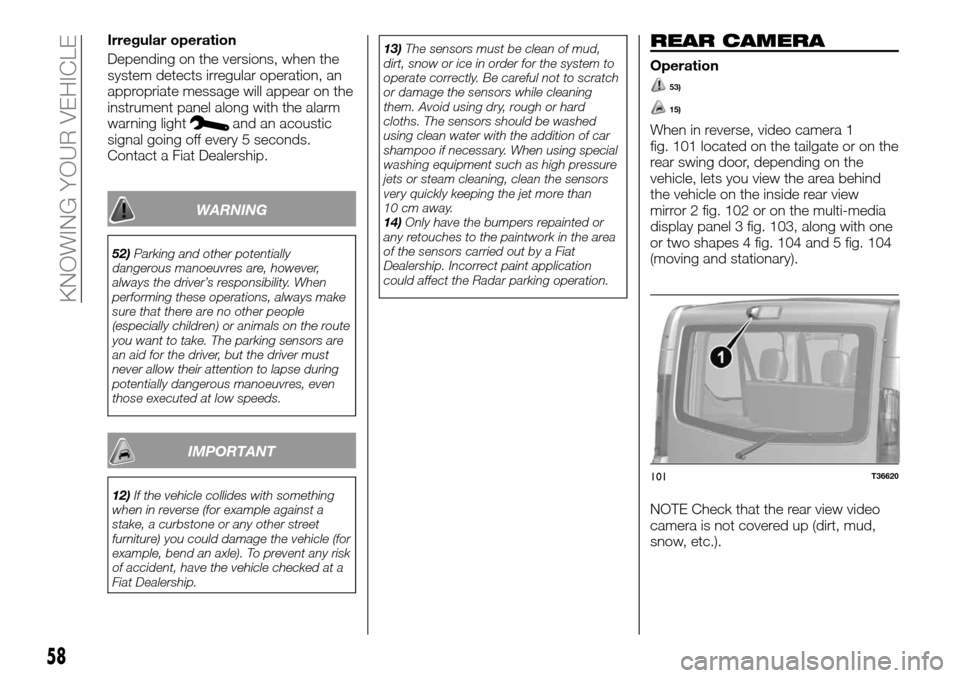
Irregular operation
Depending on the versions, when the
system detects irregular operation, an
appropriate message will appear on the
instrument panel along with the alarm
warning light
and an acoustic
signal going off every 5 seconds.
Contact a Fiat Dealership.
WARNING
52)Parking and other potentially
dangerous manoeuvres are, however,
always the driver’s responsibility. When
performing these operations, always make
sure that there are no other people
(especially children) or animals on the route
you want to take. The parking sensors are
an aid for the driver, but the driver must
never allow their attention to lapse during
potentially dangerous manoeuvres, even
those executed at low speeds.
IMPORTANT
12)If the vehicle collides with something
when in reverse (for example against a
stake, a curbstone or any other street
furniture) you could damage the vehicle (for
example, bend an axle). To prevent any risk
of accident, have the vehicle checked at a
Fiat Dealership.13)The sensors must be clean of mud,
dirt, snow or ice in order for the system to
operate correctly. Be careful not to scratch
or damage the sensors while cleaning
them. Avoid using dry, rough or hard
cloths. The sensors should be washed
using clean water with the addition of car
shampoo if necessary. When using special
washing equipment such as high pressure
jets or steam cleaning, clean the sensors
very quickly keeping the jet more than
10 cm away.
14)Only have the bumpers repainted or
any retouches to the paintwork in the area
of the sensors carried out by a Fiat
Dealership. Incorrect paint application
could affect the Radar parking operation.
REAR CAMERA
Operation
53)
15)
When in reverse, video camera 1
fig. 101 located on the tailgate or on the
rear swing door, depending on the
vehicle, lets you view the area behind
the vehicle on the inside rear view
mirror 2 fig. 102 or on the multi-media
display panel 3 fig. 103, along with one
or two shapes 4 fig. 104 and 5 fig. 104
(moving and stationary).
NOTE Check that the rear view video
camera is not covered up (dirt, mud,
snow, etc.).
101T36620
58
KNOWING YOUR VEHICLE
Page 61 of 232
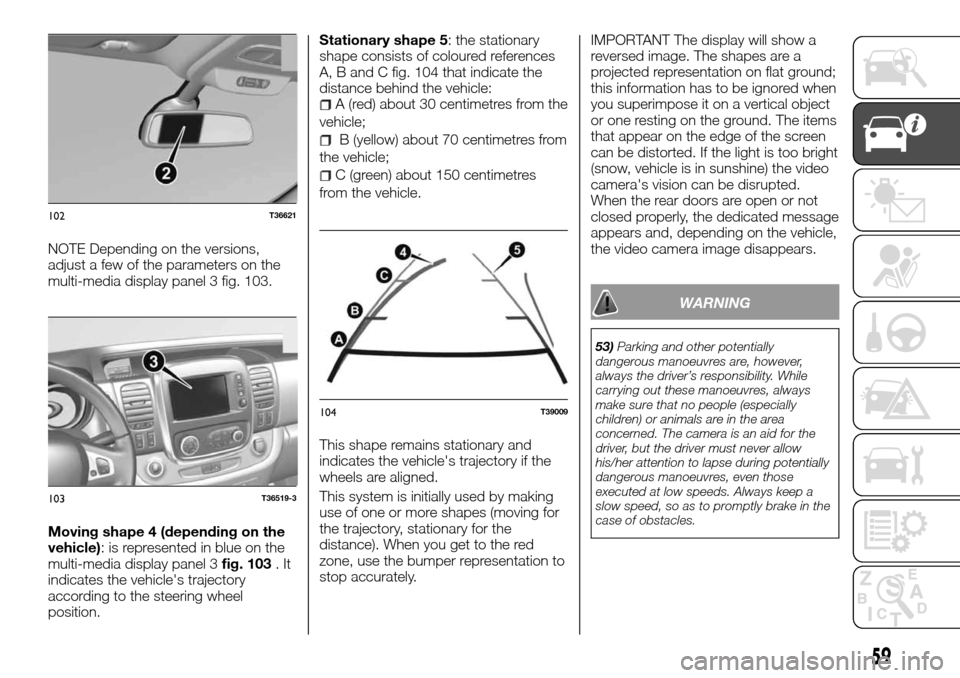
NOTE Depending on the versions,
adjust a few of the parameters on the
multi-media display panel 3 fig. 103.
Moving shape 4 (depending on the
vehicle): is represented in blue on the
multi-media display panel 3fig. 103.It
indicates the vehicle's trajectory
according to the steering wheel
position.Stationary shape 5: the stationary
shape consists of coloured references
A, B and C fig. 104 that indicate the
distance behind the vehicle:
A (red) about 30 centimetres from the
vehicle;
B (yellow) about 70 centimetres from
the vehicle;
C (green) about 150 centimetres
from the vehicle.
This shape remains stationary and
indicates the vehicle's trajectory if the
wheels are aligned.
This system is initially used by making
use of one or more shapes (moving for
the trajectory, stationary for the
distance). When you get to the red
zone, use the bumper representation to
stop accurately.IMPORTANT The display will show a
reversed image. The shapes are a
projected representation on flat ground;
this information has to be ignored when
you superimpose it on a vertical object
or one resting on the ground. The items
that appear on the edge of the screen
can be distorted. If the light is too bright
(snow, vehicle is in sunshine) the video
camera's vision can be disrupted.
When the rear doors are open or not
closed properly, the dedicated message
appears and, depending on the vehicle,
the video camera image disappears.
WARNING
53)Parking and other potentially
dangerous manoeuvres are, however,
always the driver’s responsibility. While
carrying out these manoeuvres, always
make sure that no people (especially
children) or animals are in the area
concerned. The camera is an aid for the
driver, but the driver must never allow
his/her attention to lapse during potentially
dangerous manoeuvres, even those
executed at low speeds. Always keep a
slow speed, so as to promptly brake in the
case of obstacles.
102T36621
103T36519-3
104T39009
59
Page 70 of 232
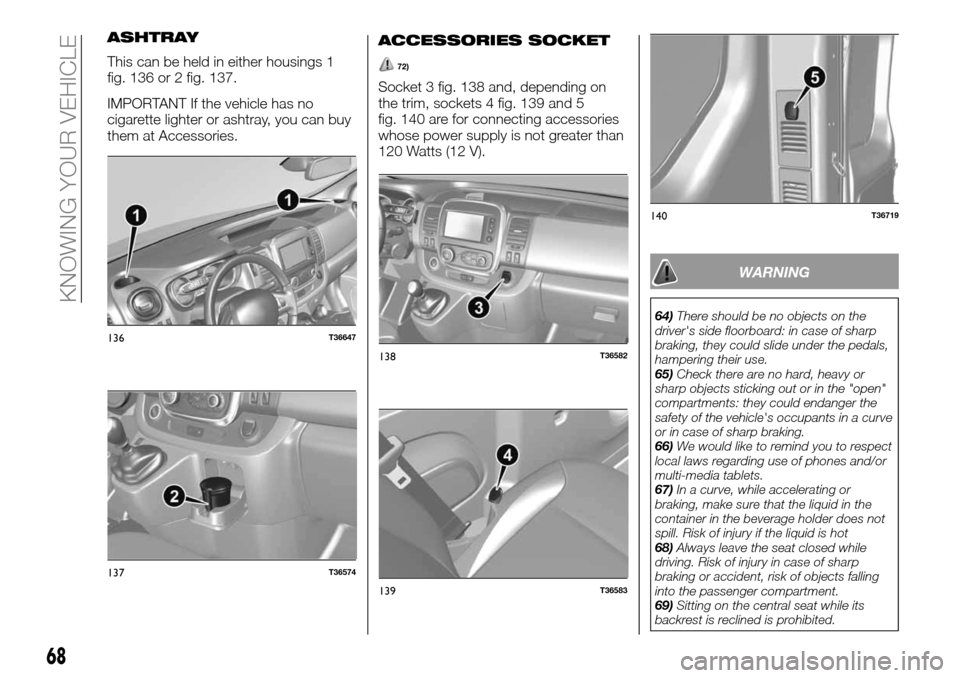
ACCESSORIES SOCKET
72)
Socket 3 fig. 138 and, depending on
the trim, sockets 4 fig. 139 and 5
fig. 140 are for connecting accessories
whose power supply is not greater than
120 Watts (12 V).
WARNING
64)There should be no objects on the
driver's side floorboard: in case of sharp
braking, they could slide under the pedals,
hampering their use.
65)Check there are no hard, heavy or
sharp objects sticking out or in the "open"
compartments: they could endanger the
safety of the vehicle's occupants in a curve
or in case of sharp braking.
66)We would like to remind you to respect
local laws regarding use of phones and/or
multi-media tablets.
67)In a curve, while accelerating or
braking, make sure that the liquid in the
container in the beverage holder does not
spill. Risk of injury if the liquid is hot
68)Always leave the seat closed while
driving. Risk of injury in case of sharp
braking or accident, risk of objects falling
into the passenger compartment.
69)Sitting on the central seat while its
backrest is reclined is prohibited.
136T36647
137T36574
138T36582
139T36583
140T36719
68
KNOWING YOUR VEHICLE
ASHTRAY
This can be held in either housings 1
fig. 136 or 2 fig. 137.
IMPORTANT If the vehicle has no
cigarette lighter or ashtray, you can buy
them at Accessories.
Page 72 of 232
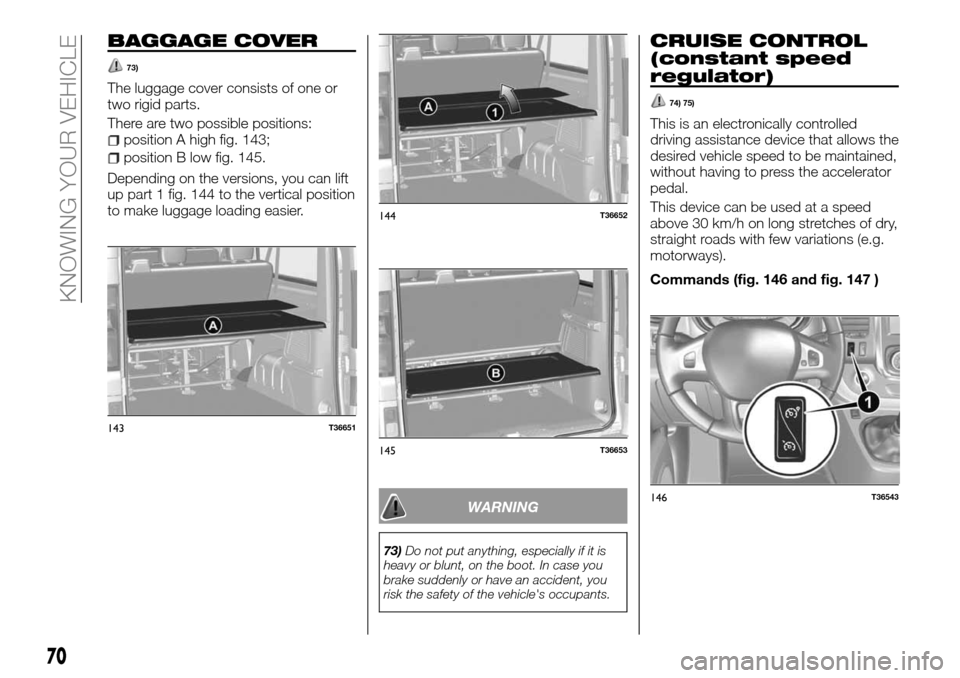
BAGGAGE COVER
73)
The luggage cover consists of one or
two rigid parts.
There are two possible positions:
position A high fig. 143;
position B low fig. 145.
Depending on the versions, you can lift
up part 1 fig. 144 to the vertical position
to make luggage loading easier.
WARNING
73)Do not put anything, especially if it is
heavy or blunt, on the boot. In case you
brake suddenly or have an accident, you
risk the safety of the vehicle's occupants.
CRUISE CONTROL
(constant speed
regulator)
74) 75)
This is an electronically controlled
driving assistance device that allows the
desired vehicle speed to be maintained,
without having to press the accelerator
pedal.
This device can be used at a speed
above 30 km/h on long stretches of dry,
straight roads with few variations (e.g.
motorways).
Commands (fig. 146 and fig. 147 )
143T36651
144T36652
145T36653
146T36543
70
KNOWING YOUR VEHICLE
Page 74 of 232
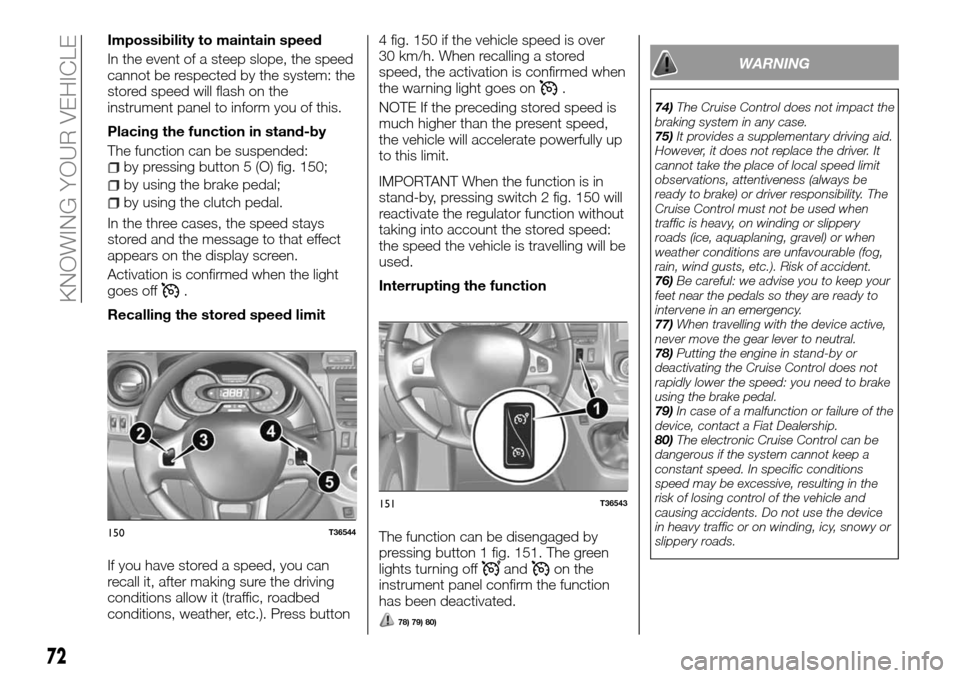
Impossibility to maintain speed
In the event of a steep slope, the speed
cannot be respected by the system: the
stored speed will flash on the
instrument panel to inform you of this.
Placing the function in stand-by
The function can be suspended:
by pressing button 5 (O) fig. 150;
by using the brake pedal;
by using the clutch pedal.
In the three cases, the speed stays
stored and the message to that effect
appears on the display screen.
Activation is confirmed when the light
goes off
.
Recalling the stored speed limit
If you have stored a speed, you can
recall it, after making sure the driving
conditions allow it (traffic, roadbed
conditions, weather, etc.). Press button4 fig. 150 if the vehicle speed is over
30 km/h. When recalling a stored
speed, the activation is confirmed when
the warning light goes on
.
NOTE If the preceding stored speed is
much higher than the present speed,
the vehicle will accelerate powerfully up
to this limit.
IMPORTANT When the function is in
stand-by, pressing switch 2 fig. 150 will
reactivate the regulator function without
taking into account the stored speed:
the speed the vehicle is travelling will be
used.
Interrupting the function
The function can be disengaged by
pressing button 1 fig. 151. The green
lights turning off
andon the
instrument panel confirm the function
has been deactivated.
78) 79) 80)
WARNING
74)The Cruise Control does not impact the
braking system in any case.
75)It provides a supplementary driving aid.
However, it does not replace the driver. It
cannot take the place of local speed limit
observations, attentiveness (always be
ready to brake) or driver responsibility. The
Cruise Control must not be used when
traffic is heavy, on winding or slippery
roads (ice, aquaplaning, gravel) or when
weather conditions are unfavourable (fog,
rain, wind gusts, etc.). Risk of accident.
76)Be careful: we advise you to keep your
feet near the pedals so they are ready to
intervene in an emergency.
77)When travelling with the device active,
never move the gear lever to neutral.
78)Putting the engine in stand-by or
deactivating the Cruise Control does not
rapidly lower the speed: you need to brake
using the brake pedal.
79)In case of a malfunction or failure of the
device, contact a Fiat Dealership.
80)The electronic Cruise Control can be
dangerous if the system cannot keep a
constant speed. In specific conditions
speed may be excessive, resulting in the
risk of losing control of the vehicle and
causing accidents. Do not use the device
in heavy traffic or on winding, icy, snowy or
slippery roads.
150T36544
151T36543
72
KNOWING YOUR VEHICLE
Page 77 of 232

PROTECTING THE
ENVIRONMENT
Temperature of the exhaust gases
The system controlling the exhaust lets
you identify the malfunctions of the
vehicle's anti-pollution device. These
faults can cause an excess in polluting
emissions and cause mechanical
damage.
This warning light on the instrument
panel indicates any system function
failure:
If it stays on, contact a Fiat
Dealership as soon as possible;
If it flashes, you need to reduce the
engine running until the flashing stops.
Contact a Fiat Dealership as soon as
possible.
Refer to the information in the "AdBblue
additive tank" paragraph in the
"Knowing your vehicle" chapter.
The vehicle was designed with
environmental friendliness in mind for its
entire life cycle: from manufacture to
use up to the end of its life cycle. This
commitment is demonstrated by the
writing eco
2.Manufacture
The vehicle's manufacture has been
carried out at an industrial factory that
applies advanced procedures aimed at
environmental impact reduction with
respect to the inhabitants and nature in
the surrounding areas (reduction of
water and power consumption,
atmospheric and water emissions,
disposal and evaluation of waste.
Emissions
While it is being used, the vehicle was
designed to emit a lower quantity of
greenhouse gasses (CO
2) and
therefore lower consumption (ex.:
170 g/km amounts to 6.4 l/100 km for
a Diesel vehicle).
Moreover, the vehicles are equipped
with anti-pollution systems such as the
catalytic exhaust, oxygen sensor, etc.
For some vehicles, this system is
rounded out with an anti-particulate
filter that allows a reduction in particle
emissions.
Used and replaced parts on sale during
regular servicing (battery, oil filter, air
filter, batteries, etc.) and oil tanks (both
empty and full of used oil) must be
delivered to specialised waste disposal
consortiums.To hand the vehicle over at the end of
its life without extra cost, contact one of
our dealerships if you are purchasing
another vehicle or an FCA-authorised
collection and scrapping centre. These
centres have been carefully chosen to
offer high quality service for the
collection, treatment and recycling of
vehicles at their end of life, respecting
the surrounding environment.
Recyclability
The vehicle is 85% recyclable and 95%
recoverable.
To achieve these aims, several of the
vehicle's parts have been designed so
they can be recycled. The structure and
materials have been especially studied
to facilitate dismantling of these
components and their re-treatment in
specific chains.
In order to preserve raw material
resources, the vehicle incorporates
several parts in recycled plastic or
renewable materials (plant or animal like
cotton or wool).
75
Page 85 of 232
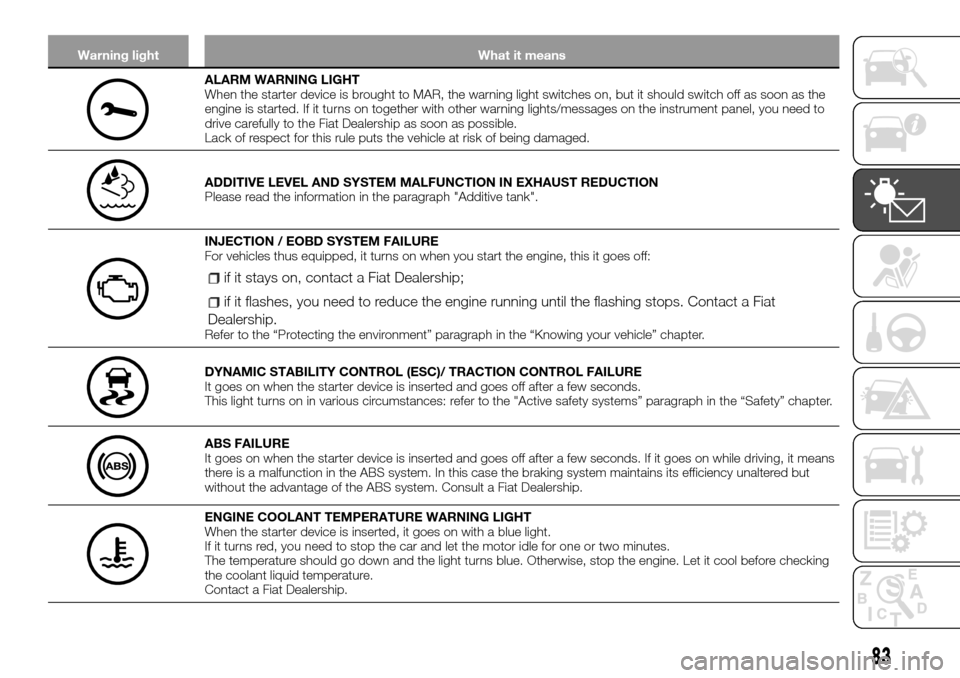
Warning light What it means
ALARM WARNING LIGHT
When the starter device is brought to MAR, the warning light switches on, but it should switch off as soon as the
engine is started. If it turns on together with other warning lights/messages on the instrument panel, you need to
drive carefully to the Fiat Dealership as soon as possible.
Lack of respect for this rule puts the vehicle at risk of being damaged.
ADDITIVE LEVEL AND SYSTEM MALFUNCTION IN EXHAUST REDUCTION
Please read the information in the paragraph "Additive tank".
INJECTION / EOBD SYSTEM FAILURE
For vehicles thus equipped, it turns on when you start the engine, this it goes off:
if it stays on, contact a Fiat Dealership;
if it flashes, you need to reduce the engine running until the flashing stops. Contact a Fiat
Dealership.
Refer to the “Protecting the environment” paragraph in the “Knowing your vehicle” chapter.
DYNAMIC STABILITY CONTROL (ESC)/ TRACTION CONTROL FAILURE
It goes on when the starter device is inserted and goes off after a few seconds.
This light turns on in various circumstances: refer to the "Active safety systems” paragraph in the “Safety” chapter.
ABS FAILURE
It goes on when the starter device is inserted and goes off after a few seconds. If it goes on while driving, it means
there is a malfunction in the ABS system. In this case the braking system maintains its efficiency unaltered but
without the advantage of the ABS system. Consult a Fiat Dealership.
ENGINE COOLANT TEMPERATURE WARNING LIGHT
When the starter device is inserted, it goes on with a blue light.
If it turns red, you need to stop the car and let the motor idle for one or two minutes.
The temperature should go down and the light turns blue. Otherwise, stop the engine. Let it cool before checking
the coolant liquid temperature.
Contact a Fiat Dealership.
83
Page 99 of 232
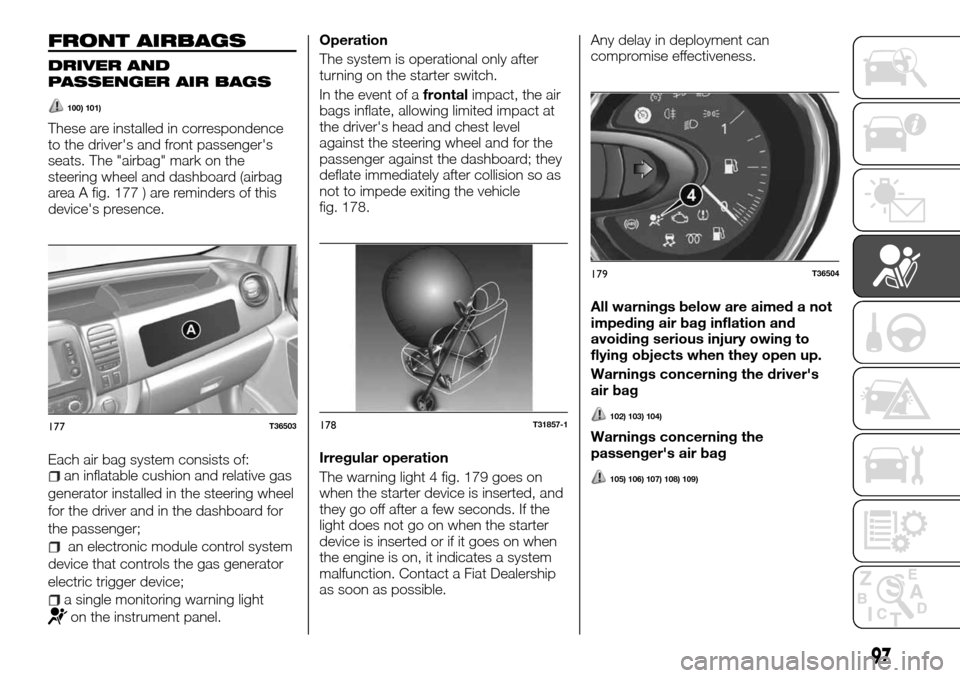
FRONT AIRBAGS
DRIVER AND
PASSENGER AIR BAGS
100) 101)
These are installed in correspondence
to the driver's and front passenger's
seats. The "airbag" mark on the
steering wheel and dashboard (airbag
area A fig. 177 ) are reminders of this
device's presence.
Each air bag system consists of:
an inflatable cushion and relative gas
generator installed in the steering wheel
for the driver and in the dashboard for
the passenger;
an electronic module control system
device that controls the gas generator
electric trigger device;
a single monitoring warning light
on the instrument panel.Operation
The system is operational only after
turning on the starter switch.
In the event of afrontalimpact, the air
bags inflate, allowing limited impact at
the driver's head and chest level
against the steering wheel and for the
passenger against the dashboard; they
deflate immediately after collision so as
not to impede exiting the vehicle
fig. 178.
Irregular operation
The warning light 4 fig. 179 goes on
when the starter device is inserted, and
they go off after a few seconds. If the
light does not go on when the starter
device is inserted or if it goes on when
the engine is on, it indicates a system
malfunction. Contact a Fiat Dealership
as soon as possible.Any delay in deployment can
compromise effectiveness.
All warnings below are aimed a not
impeding air bag inflation and
avoiding serious injury owing to
flying objects when they open up.
Warnings concerning the driver's
air bag
102) 103) 104)
Warnings concerning the
passenger's air bag
105) 106) 107) 108) 109)
177T36503178T31857-1
179T36504
97
Page 101 of 232
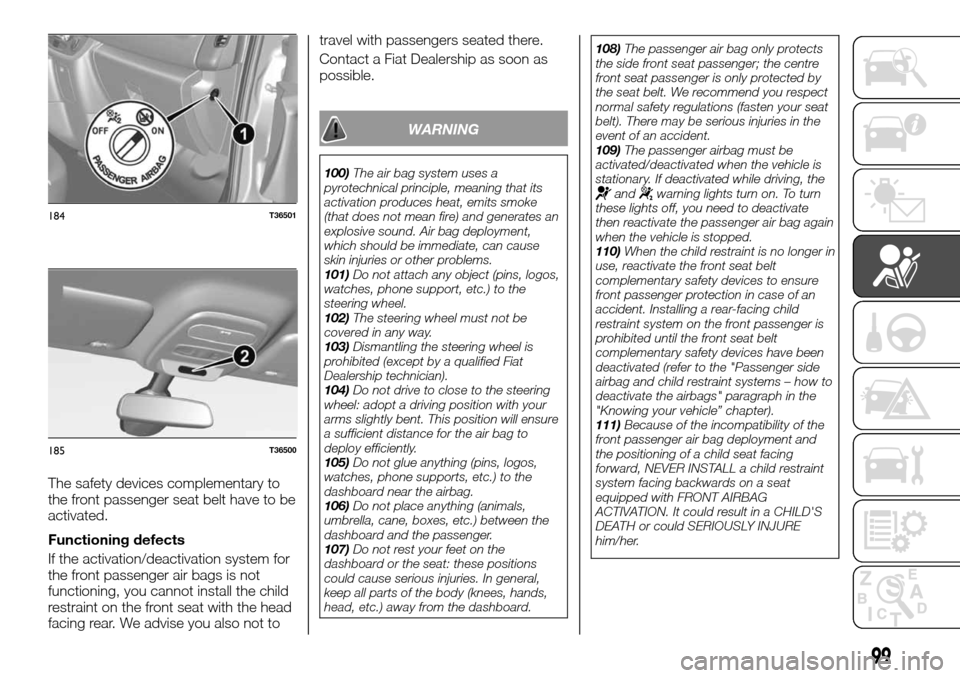
The safety devices complementary to
the front passenger seat belt have to be
activated.
Functioning defects
If the activation/deactivation system for
the front passenger air bags is not
functioning, you cannot install the child
restraint on the front seat with the head
facing rear. We advise you also not totravel with passengers seated there.
Contact a Fiat Dealership as soon as
possible.
WARNING
100)The air bag system uses a
pyrotechnical principle, meaning that its
activation produces heat, emits smoke
(that does not mean fire) and generates an
explosive sound. Air bag deployment,
which should be immediate, can cause
skin injuries or other problems.
101)Do not attach any object (pins, logos,
watches, phone support, etc.) to the
steering wheel.
102)The steering wheel must not be
covered in any way.
103)Dismantling the steering wheel is
prohibited (except by a qualified Fiat
Dealership technician).
104)Do not drive to close to the steering
wheel: adopt a driving position with your
arms slightly bent. This position will ensure
a sufficient distance for the air bag to
deploy efficiently.
105)Do not glue anything (pins, logos,
watches, phone supports, etc.) to the
dashboard near the airbag.
106)Do not place anything (animals,
umbrella, cane, boxes, etc.) between the
dashboard and the passenger.
107)Do not rest your feet on the
dashboard or the seat: these positions
could cause serious injuries. In general,
keep all parts of the body (knees, hands,
head, etc.) away from the dashboard.108)The passenger air bag only protects
the side front seat passenger; the centre
front seat passenger is only protected by
the seat belt. We recommend you respect
normal safety regulations (fasten your seat
belt). There may be serious injuries in the
event of an accident.
109)The passenger airbag must be
activated/deactivated when the vehicle is
stationary. If deactivated while driving, the
andwarning lights turn on. To turn
these lights off, you need to deactivate
then reactivate the passenger air bag again
when the vehicle is stopped.
110)When the child restraint is no longer in
use, reactivate the front seat belt
complementary safety devices to ensure
front passenger protection in case of an
accident. Installing a rear-facing child
restraint system on the front passenger is
prohibited until the front seat belt
complementary safety devices have been
deactivated (refer to the "Passenger side
airbag and child restraint systems – how to
deactivate the airbags" paragraph in the
"Knowing your vehicle” chapter).
111)Because of the incompatibility of the
front passenger air bag deployment and
the positioning of a child seat facing
forward, NEVER INSTALL a child restraint
system facing backwards on a seat
equipped with FRONT AIRBAG
ACTIVATION. It could result in a CHILD'S
DEATH or could SERIOUSLY INJURE
him/her.
184T36501
185T36500
99
Page 103 of 232
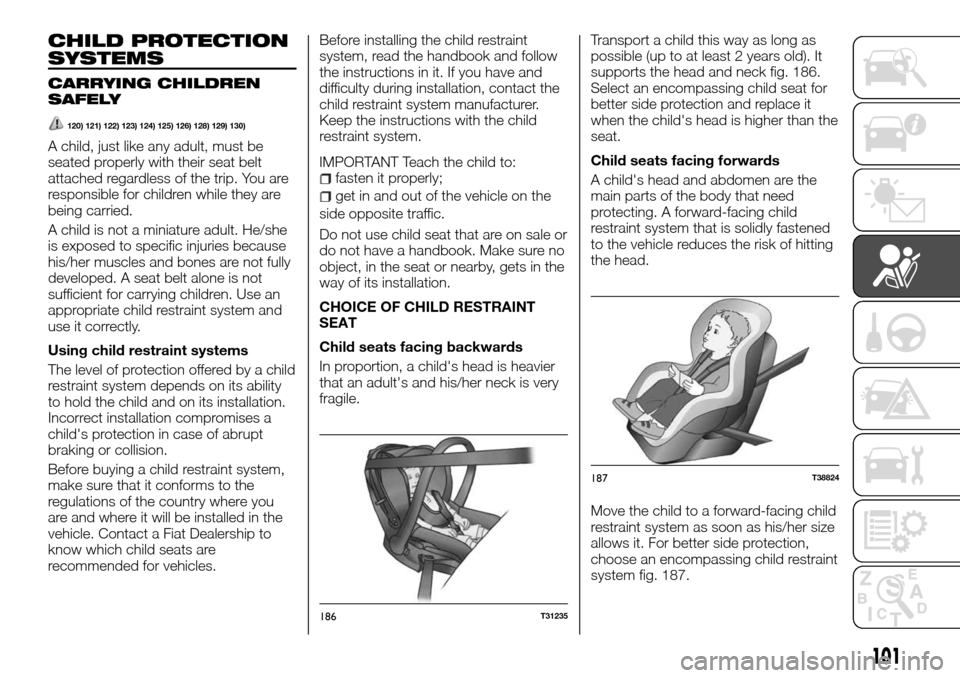
CHILD PROTECTION
SYSTEMS
CARRYING CHILDREN
SAFELY
120) 121) 122) 123) 124) 125) 126) 128) 129) 130)
A child, just like any adult, must be
seated properly with their seat belt
attached regardless of the trip. You are
responsible for children while they are
being carried.
A child is not a miniature adult. He/she
is exposed to specific injuries because
his/her muscles and bones are not fully
developed. A seat belt alone is not
sufficient for carrying children. Use an
appropriate child restraint system and
use it correctly.
Using child restraint systems
The level of protection offered by a child
restraint system depends on its ability
to hold the child and on its installation.
Incorrect installation compromises a
child's protection in case of abrupt
braking or collision.
Before buying a child restraint system,
make sure that it conforms to the
regulations of the country where you
are and where it will be installed in the
vehicle. Contact a Fiat Dealership to
know which child seats are
recommended for vehicles.Before installing the child restraint
system, read the handbook and follow
the instructions in it. If you have and
difficulty during installation, contact the
child restraint system manufacturer.
Keep the instructions with the child
restraint system.
IMPORTANT Teach the child to:
fasten it properly;
get in and out of the vehicle on the
side opposite traffic.
Do not use child seat that are on sale or
do not have a handbook. Make sure no
object, in the seat or nearby, gets in the
way of its installation.
CHOICE OF CHILD RESTRAINT
SEAT
Child seats facing backwards
In proportion, a child's head is heavier
that an adult's and his/her neck is very
fragile.Transport a child this way as long as
possible (up to at least 2 years old). It
supports the head and neck fig. 186.
Select an encompassing child seat for
better side protection and replace it
when the child's head is higher than the
seat.
Child seats facing forwards
A child's head and abdomen are the
main parts of the body that need
protecting. A forward-facing child
restraint system that is solidly fastened
to the vehicle reduces the risk of hitting
the head.
Move the child to a forward-facing child
restraint system as soon as his/her size
allows it. For better side protection,
choose an encompassing child restraint
system fig. 187.
186T31235
187T38824
101